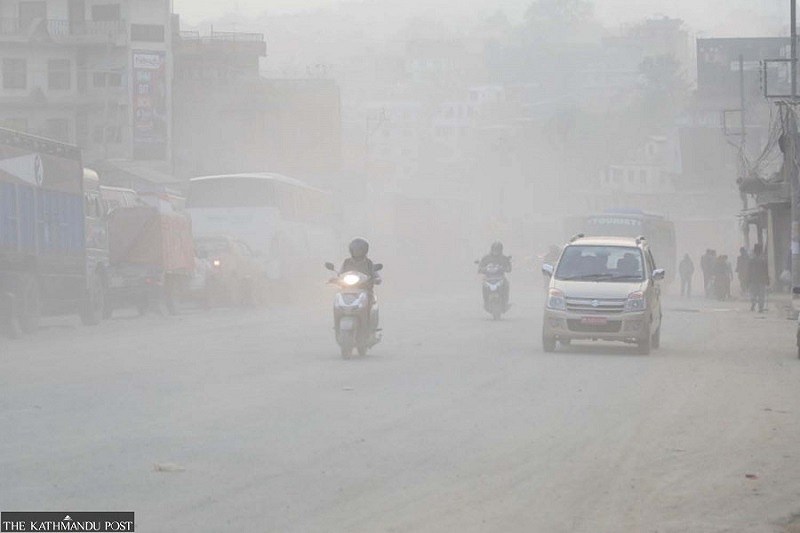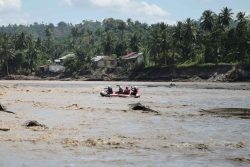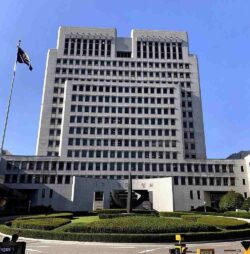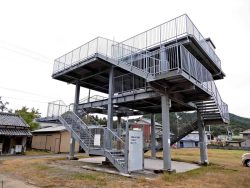
Doctors say young people also suffer from COPD and the problem has been growing more severe in rural areas and big cities.
16:40 JST, September 3, 2022
On Aug. 19, a 32-year-old man from Kapilvastu district was admitted to the Tribhuvan University Teaching Hospital due to complications caused by severe lung pneumonia. Due to a tuberculosis infection, both lungs of the patient have been damaged severely.
“The man is a regular patient of our hospital, as he needs oxygen therapy frequently,” said Dr. Niraj Bam, associate professor at the Institute of Medicine. “This patient stays more in hospital than at home due to lung problems. Such patients are thousands in numbers throughout the country.”
According to a new study, Nepal had the world’s highest age standardized death rates for chronic lung disease caused by air pollution in 2019 — 182.5 per 100,000 population with 3,318.4 years lost to ill health or disability.
The age-standardized death rate indicates the number of deaths per 100,000 persons of the mean population, when the age structure is kept categorically unchanged during the whole reference period.
The high prevalence of lung disease is not uncommon in Nepal. The report’s findings are also not surprising to experts, as various studies carried out in the past indicated that lung disease is the number one killer in the country.
“What is concerning is the problems have not been lessening despite knowing its burden on society,” said Dr. Megnath Dhimal, chief researcher at the Nepal Health Research Council.
The prevalence of chronic obstructive pulmonary diseases (COPD) surpassed all non-communicable diseases — coronary artery disease, diabetes, and kidney disease — in the country, according to a study carried out by the council in the past.
Likewise, chronic obstructive pulmonary disease was responsible for 16.3% of total deaths in 2019, an increase from 6.1% in 1990.
Nearly all cases of COPD are environmental in origin, Jay Kaufman, an author of the study and professor in the Department of Epidemiology, Biostatistics and Occupational Health and McGill University in Montreal, Canada, was quoted as saying by SciDev.Net.
Smoking, indoor air pollution from cooking, heating, outdoor air pollution, infections — tuberculosis, childhood pneumonia, and lung cancer are considered reasons for high COPD prevalence in the country.
Doctors say young people also suffer from COPD and the problem has been growing more severe in rural areas and big cities.
“High prevalence rate of COPD in a rural setting is understandable, as people use firewood for cooking,” said Dr. Aashes Dhungana, a pulmonologist at Bir Hospital. “But the number of COPD patients is not less in big cities. Even children and young people are suffering from the problem.”
In March, haze covered the Kathmandu Valley and the air quality reached unhealthy levels. Environmentalists blamed open burning activities and incidents of forest fire across the country for the increase in air pollution level.
The pollution level worsened in 2021, too. Authorities concerned had issued a red alert and enforced school closure to lessen adverse effects of rising air pollution on students’ health.
IQAir, a Swiss group that collects air-quality data from around the world, ranked Nepal among the top 10 countries having the worst air quality in 2021.
Emissions from vehicles along with brick kilns are considered to be major contributors to air pollution in the country.
Population-based survey of the prevalence of selected chronic non-communicable diseases in Nepal, carried out by the Nepal Health Research Council in 2019, showed that 25.1% of the Karnali region’s population — one in every four people — suffer from chronic obstructive pulmonary diseases, the highest number in the country.
The study showed that 16.4% of the total population — which is one in every six people — in Madhesh Province; 14.3% — one in every seven people — in Sudurpaschim Province; 11.7% — one in every nine people — in Bagmati Province; 9.5% — one in every 10 people — in Lumbini Province; 6.2% — one in every 16 people — in Province 1; and 6% — one in every 16 people — in Gandaki Province suffer from chronic obstructive pulmonary diseases.
The study showed that over three million people across the country suffer from respiratory problems, but only 3% receive proper treatment.
“Some of the patients are visiting the hospital in a critical stage and we have to admit them in the intensive care unit, ” said Dr. Hem Raj Paneru, senior consultant intensivist at HAMS Hospital.
Doctors say that due to the lack of a proper case management system and timely medical intervention in the country, many people suffering from COPD have been deprived of treatment.
Officials at the Ministry of Health and Population concede a lack of proper and timely medical intervention but claim that many measures have been taken to lessen the disease burden.
“We have been trying to address the problems through the package of essential non-communicable diseases,” said Dr. Phanindra Baral, chief of the non-communicable section at the Epidemiology and Disease Control Division. “Some medicines for COPD have been included in the free drug list. Measures are also being taken to lessen indoor air pollution, awareness is being launched to lessen tobacco use and environmental pollution.”
The study pointed at behavioural risk factors like tobacco use as the main reason for the rise in patients suffering from chronic obstructive pulmonary diseases.
According to doctors, the worsening air quality of Kathmandu Valley is also considered one of the reasons behind a sharp increase in respiratory problems including seven problems in patients infected with the coronavirus, according to doctors.
They say that the prevalence of chronic obstructive pulmonary diseases can be lessened by changing behavioural patterns, such as discouraging the use of tobacco and firewood in rural areas and implementing effective measures to reduce air pollution in the cities.
“Multiple factors including bacterial, viral and behaviour are responsible for the rise in COPD cases and it is not only in Nepal but across the globe,” said Dahal, a pulmonologist. “What concerns us is that measures taken to lessen the problems in our country are yet to show positive results.”
"World" POPULAR ARTICLE
-

8 Japanese Nationals Stranded on Indonesia’s Sumatra Island
-

U.S. Senate Resolution Backs Japan, Condemns China’s Pressure
-

Mozambican Cooking Class Held in Matsuyama, Ehime Pref.; Participants Don Aprons, Bandanas Made from Traditional Mozambique Fabric
-

China to Impose Sanctions on Shigeru Iwasaki, Former Head of Japan’s Self-Defense Forces, Who Serves as Adviser to Taiwan’s Executive Branch
-

South Korea’s Top Court Dismisses Nippon Steel Appeal in Lawsuit over Requisitioned Worker
JN ACCESS RANKING
-

Tokyo Economic Security Forum to Hold Inaugural Meeting Amid Tense Global Environment
-

Keidanren Chairman Yoshinobu Tsutsui Visits Kashiwazaki-Kariwa Nuclear Power Plant; Inspects New Emergency Safety System
-

Imports of Rare Earths from China Facing Delays, May Be Caused by Deterioration of Japan-China Relations
-

University of Tokyo Professor Discusses Japanese Economic Security in Interview Ahead of Forum
-

Japan Pulls out of Vietnam Nuclear Project, Complicating Hanoi’s Power Plans






















